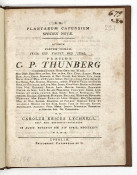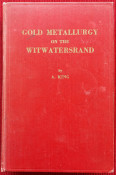First Edition: PARTS 1 - 4. Dissertations by C.E. Lychnell, C.F. Ewert, P.A. Fröst & O.L. Fogelmarck. 1. (ii), 8. 2. (ii), 9 - 18. 3. (iv), 19 - 26, 4. (ii), 27 - 32 pages, recently bound in brown faux leather, a very good copy.
A South African Bibliography, Volume 4, page 504, rare with all four parts. A catalogue of plants discovered at the Cape.
(https://en.wikipedia.org/wiki/Carl_Peter_Thunberg), 'Carl Peter Thunberg, also known as Karl Peter von Thunberg, Carl Pehr Thunberg, or Carl Per Thunberg (11 November 1743 – 8 August 1828), was a Swedish naturalist and an "apostle" of Carl Linnaeus. After studying under Linnaeus at Uppsala University, he spent seven years travelling in southern Italy and Asia, collecting and describing people and animals new to European science, and observing local cultures. He has been called "the father of South African botany", "pioneer of Occidental Medicine in Japan", and the "Japanese Linnaeus".
'During his three-year stay, Thunberg perfected his Dutch and studied the culture of the Khoikhoi, (known to the Dutch as "Hottentotten"), the native people of western South Africa. The Khoikhoi were the first non-European culture he encountered. Their customs and traditions elicited both his disgust and admiration. For example, he considered their custom to grease their skin with fat and dust as an obnoxious habit about which he wrote in his travelogue: "For uncleanliness, the Hottentots have the greatest love. They grease their entire body with greasy substances and above this, they put cow dung, fat or something similar." Yet, this harsh judgement is moderated by the reason he saw for this practice and so he continues that: "This stops up their pores and their skin is covered with a thick layer which protects it from heat in Summer and from cold during Winter." This attitude – to try to justify rituals he did not understand – also marked his encounters with Japanese people.
'Since the main purpose for his journey was to collect specimens for the gardens in Leiden, Thunberg regularly took field trips into the interior of South Africa. Between September 1772 and January 1773, he accompanied the Dutch superintendent of the V.O.C. garden, Johan Andreas Auge. Their journey took them to the north of Saldanha Bay, east along the Breede Valley through the Langkloof as far as the Gamtoos River and returning by way of the Little Karoo. During this expedition and later, Thunberg kept in regular contact with scholars in Europe, especially the Netherlands and Sweden, but also with other members of the V.O.C. who sent him animal skins. Shortly after returning, Thunberg met Francis Masson, a Scots gardener who had come to Cape Town to collect plants for the Royal Gardens at Kew. They were drawn together by their shared interests. During one of their trips, they were joined by Robert Jacob Gordon, on leave from his regiment in the Netherlands. Together, the scientists undertook two further inland expeditions.
'During his three expeditions into the interior, Thunberg collected many specimens of both flora and fauna. At the initiative of Linnaeus, he graduated at Uppsala as Doctor of Medicine in absentia while he was at the Cape in 1772. Thunberg left the Cape for Batavia on 2 March 1775. He arrived in Batavia on 18 May 1775, and left for Japan on 20 June.'
- Overall Condition: Very good
- Size: Small 4to (215 x 160 mm)












